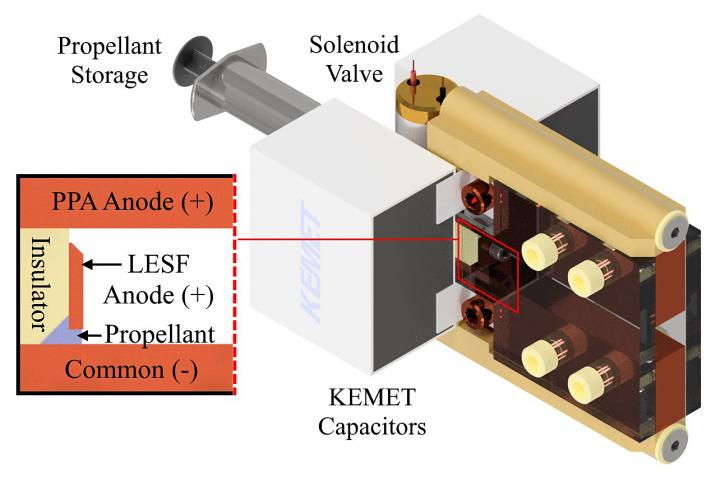New safer, inexpensive way to propel small satellites

Purdue University researchers have created a novel micropropulsion system for nanosatellite applications using a liquid fed pulsed-plasma thruster. Credit: Purdue University/Alexey Shashurin
Finding inexpensive solutions for propelling CubeSats is one of the most critical components of the rapidly growing industry of commercial launches of satellites the size of a loaf of bread. The small size and relatively low cost have made CubeSats popular choices for commercial launches in recent years.
The first CubeSat was launched in 1999. Since then, more than 1,000 have been launched. The rapid development and application of nanosatellite technology has vastly accelerated mission complexity – sparking interest in robust, low-power and high-specific impulse micropropulsion systems.
Purdue University researchers have created a novel micropropulsion system for nanosatellite applications using a liquid fed pulsed-plasma thruster. It uses a liquid propellant for Lorentz-force pulsed-plasma accelerator and extended lifetime ignition system driven by nanosecond long pulses.
“Our innovation helps address current challenges with CubeSat micropropulsion systems, including short operational lifetimes, contamination risks and economic challenges,” said Alexey Shashurin, an assistant professor of aeronautics and astronautics in Purdue's College of Engineering. “Our system is better able to operate reliably for the entire mission and the liquid propellant we use does not create the contamination risks to the subsystems that we see with current options.”
The Purdue team's work was presented in June at the 2019 IEEE Pulsed Power and Plasma Science Conference in Orlando, Florida.
Overall popularity of the CubeSats is driven heavily by the great advancement in miniaturization of electronic components and sensors that allows for new kinds of space missions and measurements using a CubeSat.
“We have taken the next step toward developing a robust propulsion system for CubeSats to provide for necessary maneuvering during missions,” Shashurin said. “Developing innovative technologies like this is one of my passions.”
One of the student researchers who worked on the technology, Adam Patel, was named one of “Tomorrow's Engineering Leaders” by Aviation Week Network and the American Institute of Aeronautics and Astronautics. Patel is a senior in the School of Aeronautics and Astronautics.
Shashurin and his team worked with the Purdue Research Foundation Office of Technology Commercialization to file a provisional patent on the technology. They are looking for partners to continue development.
Their work aligns with Purdue's Giant Leaps celebration of the university's global advancements in space exploration as part of Purdue's 150th anniversary. It is one of the four themes of the yearlong celebration's Ideas Festival, designed to showcase Purdue as an intellectual center solving real-world issues.
###
About Purdue Research Foundation Office of Technology Commercialization
The Purdue Research Foundation Office of Technology Commercialization operates one of the most comprehensive technology transfer programs among leading research universities in the U.S. Services provided by this office support the economic development initiatives of Purdue University and benefit the university's academic activities through commercializing, licensing and protecting Purdue intellectual property. The office is managed by the Purdue Research Foundation, which received the 2016 Innovation and Economic Prosperity Universities Award for Innovation from the Association of Public and Land-grant Universities. For more information on licensing a Purdue innovation, contact the Office of Technology Commercialization at otcip@prf.org. For more information about funding and investment opportunities in startups based on a Purdue innovation, contact the Purdue Foundry at foundry@prf.org. The Purdue Research Foundation is a private, nonprofit foundation created to advance the mission of Purdue University.
Writer: Chris Adam, 765-588-3341, cladam@prf.org
Source: Alexey Shashurin, ashashur@purdue.edu
Media Contact
All latest news from the category: Power and Electrical Engineering
This topic covers issues related to energy generation, conversion, transportation and consumption and how the industry is addressing the challenge of energy efficiency in general.
innovations-report provides in-depth and informative reports and articles on subjects ranging from wind energy, fuel cell technology, solar energy, geothermal energy, petroleum, gas, nuclear engineering, alternative energy and energy efficiency to fusion, hydrogen and superconductor technologies.
Newest articles

Silicon Carbide Innovation Alliance to drive industrial-scale semiconductor work
Known for its ability to withstand extreme environments and high voltages, silicon carbide (SiC) is a semiconducting material made up of silicon and carbon atoms arranged into crystals that is…

New SPECT/CT technique shows impressive biomarker identification
…offers increased access for prostate cancer patients. A novel SPECT/CT acquisition method can accurately detect radiopharmaceutical biodistribution in a convenient manner for prostate cancer patients, opening the door for more…

How 3D printers can give robots a soft touch
Soft skin coverings and touch sensors have emerged as a promising feature for robots that are both safer and more intuitive for human interaction, but they are expensive and difficult…





















